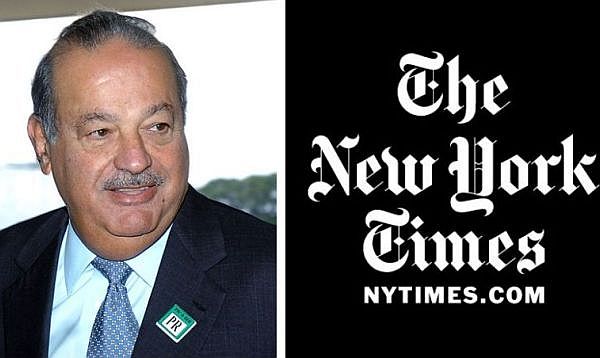Billionaire Carlos Slim has become the largest shareholder in the New York Times after already almost doubling his money from an investment that helped the newspaper in 2009.
Slim, the world’s second-richest person, loaned $250 million to Times Co. during the height of the financial crisis. After already getting repaid and then some, he has now doubled his holdings by spending nearly $101.1 million to exercise the warrants he received for that investment, a move which had to be applied before the January 15, 2015 deadline.
Slim now owns almost 17 percent of the Times' Class A shares, a stake valued at about $341.4 million.
While Slim’s financial return shows just how much Times Co. sacrificed for his help at the he was in the storied newspaper’s future - even as readers and marketers flocked to the Internet where content was largely free and ad rates were cheaper. And he hasn’t been alone in his faith in media: billionaire Jeff Bezos purchased the Washington Post in 2013 and Warren Buffett has invested in a number of local newspapers.
Slim deciding to hold on to the bigger stake is "a vote of confidence in the Times," said Ken Doctor, a media analyst for Newsonomics. "It is largely the wealthiest people who have the capacity to take on what is still a flier on the business future of the news industry."
2009 Loan
When 74-year-old Slim agreed to loan Times Co. money in 2009, the company had just canceled its dividend to preserve cash, and a credit line was set to expire. The investment bought the company enough time to find buyers for assets like the Boston Globe.
Since then, Times Co. has cleaned up its balance sheet, put up a paywall for its website and introduced new digital products.
The warrants Slim gained through the loan deal let him buy shares for about $6.36 apiece, according to regulatory filings, close to half of Times Co.’s $12.28 closing price on Wednesday. That gives Slim $5.92 in potential profit for each of the 15.9 million shares he’s allowed to buy, amounting to almost $95 million.
 |
That boosts his total stake to about 27.8 million Class A shares, or about 16.8 percent.
Today the company has a market value of about $1.9 billion.
Keep Shares
Slim's plan was always to exercise the warrants and hold on to the expanded equity stake, rather than sell the shares for an immediate profit, a person with knowledge of the matter said. Had he desired to sell them off, he would have been better off to exercise that option last April, when the stock was 37 percent higher at $17.26.
Even with the bigger stake, an unwanted takeover would still be difficult because the controlling owners - the Ochs-Sulzberger family - hold voting shares that give them a firm grip on board seats. Slim’s stake only allows him to vote for Class A directors, a group that represents no more than a third of the company’s board seats. The family’s Class B shares, which aren’t publicly traded, elect the remaining two-thirds of the board.
"What most people care about is whether or not Slim has bigger aspirations in ultimately buying the company," said William Bird, a media analyst at FBR & Co. in New York. Such a scenario is "difficult, if not impossible, to imagine" because the family has said the paper is not for sale, Bird said.
The Times intends to use the $101.1 million to buy back the Class A shares.
Trying Year
The last year has been a tumultuous one for Times Co., both in the newsroom and on the business side. In May, Chairman and Publisher Arthur Sulzberger Jr. ousted Jill Abramson as executive editor after less than three years on the job. And at the end of 2014, the paper cut more than 100 newsroom employees through buyouts and firings to save costs.
Meanwhile, the company is trying to maintain growth in online subscriptions, which totaled about 875,000 at the end of the third quarter, and print readership continues to decline. Digital ad revenue increased, but not enough to make up for the drop in print advertising.
Slim has "turned out to be very fortunate because the company’s performance certainly wouldn’t warrant a doubling" of profits, said Ed Atorino, a New York-based analyst at Benchmark Co. "They continue to reduce the staff, and they’re doing everything to ride out what they hope is not a permanent decline in advertising."
Even without the warrants, Slim had made a profit on his investment. The Times paid Slim back in 2011, including a 12 percent premium for early payment. The loan had carried an annual interest rate of 14 percent.
Dividend Payments
Plus, Slim has collected about $2.9 million in dividend payments since the dividend was reinstated in 2013. On his bigger stake, he’ll collect about $1.1 million in dividend payments each quarter. Slim didn’t disclose what he paid for the bulk of the stock he accumulated before the loan deal, making it difficult to calculate his profit on that stake.
The Times Co. investment is only one element of Slim’s empire, which ranges from banking, to energy, to retail. The bulk of his riches come from a majority stake in America Movil, the mobile-phone operator trying to sell assets in Mexico to reduce its market share.
Original Story


